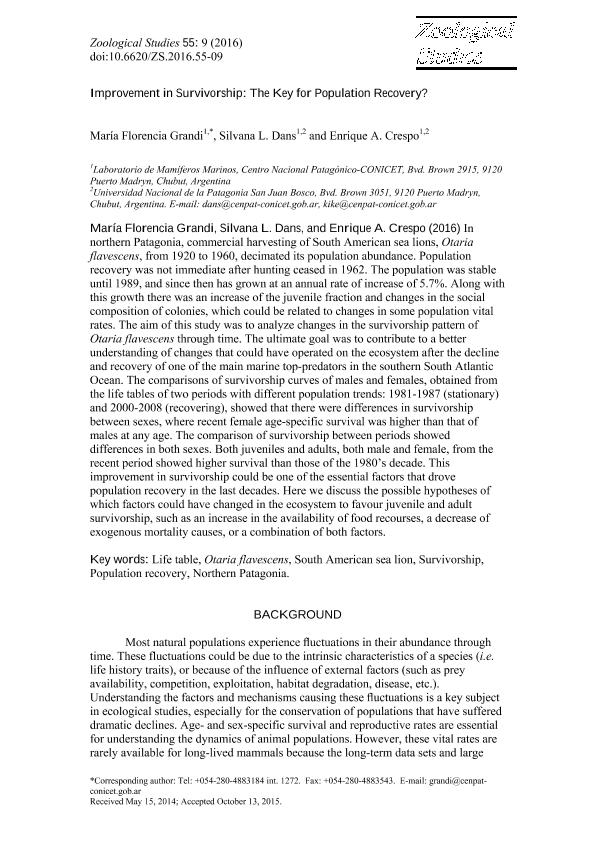Mostrar el registro sencillo del ítem
dc.contributor.author
Grandi, Maria Florencia

dc.contributor.author
Dans, Silvana Laura

dc.contributor.author
Crespo, Enrique Alberto

dc.date.available
2018-03-19T14:23:32Z
dc.date.issued
2016
dc.identifier.citation
Grandi, Maria Florencia; Dans, Silvana Laura; Crespo, Enrique Alberto; Improvement in survivorship: The key for population recovery?; Academia Sinica; Zoological Studies; 55; 9; 2016; 1-17
dc.identifier.issn
1021-5506
dc.identifier.uri
http://hdl.handle.net/11336/39174
dc.description.abstract
In northern Patagonia, commercial harvesting of South American sea lions, Otaria flavescens, from 1920 to 1960, decimated its population abundance. Population recovery was not immediate after hunting ceased in 1962. The population was stable until 1989, and since then has grown at an annual rate of increase of 5.7%. Along with this growth there was an increase of the juvenile fraction and changes in the social composition of colonies, which could be related to changes in some population vital rates. The aim of this study was to analyze changes in the survivorship pattern of Otaria flavescens through time. The ultimate goal was to contribute to a better understanding of changes that could have operated on the ecosystem after the decline and recovery of one of the main marine top-predators in the southern South Atlantic Ocean. The comparisons of survivorship curves of males and females, obtained from the life tables of two periods with different population trends: 1981-1987 (stationary) and 2000-2008 (recovering), showed that there were differences in survivorship between sexes, where recent female age-specific survival was higher than that of males at any age. The comparison of survivorship between periods showed differences in both sexes. Both juveniles and adults, both male and female, from the recent period showed higher survival than those of the 1980’s decade. This improvement in survivorship could be one of the essential factors that drove population recovery in the last decades. Here we discuss the possible hypotheses of which factors could have changed in the ecosystem to favour juvenile and adult survivorship, such as an increase in the availability of food recourses, a decrease of exogenous mortality causes, or a combination of both factors.
dc.format
application/pdf
dc.language.iso
eng
dc.publisher
Academia Sinica

dc.rights
info:eu-repo/semantics/openAccess
dc.rights.uri
https://creativecommons.org/licenses/by-nc-sa/2.5/ar/
dc.subject
Life Table
dc.subject
Northern Patagonia
dc.subject
Otaria Flavescens
dc.subject
Population Recovery
dc.subject
South American Sea Lion
dc.subject
Survivorship
dc.subject.classification
Otras Ciencias Biológicas

dc.subject.classification
Ciencias Biológicas

dc.subject.classification
CIENCIAS NATURALES Y EXACTAS

dc.title
Improvement in survivorship: The key for population recovery?
dc.type
info:eu-repo/semantics/article
dc.type
info:ar-repo/semantics/artículo
dc.type
info:eu-repo/semantics/publishedVersion
dc.date.updated
2018-03-02T15:11:33Z
dc.identifier.eissn
1810-522X
dc.journal.volume
55
dc.journal.number
9
dc.journal.pagination
1-17
dc.journal.pais
China

dc.journal.ciudad
Taiwan
dc.description.fil
Fil: Grandi, Maria Florencia. Consejo Nacional de Investigaciones Científicas y Técnicas. Centro Nacional Patagónico; Argentina
dc.description.fil
Fil: Dans, Silvana Laura. Consejo Nacional de Investigaciones Científicas y Técnicas. Centro Nacional Patagónico; Argentina. Universidad Nacional de la Patagonia; Argentina
dc.description.fil
Fil: Crespo, Enrique Alberto. Consejo Nacional de Investigaciones Científicas y Técnicas. Centro Nacional Patagónico; Argentina. Universidad Nacional de la Patagonia; Argentina
dc.journal.title
Zoological Studies

dc.relation.alternativeid
info:eu-repo/semantics/altIdentifier/doi/http://dx.doi.org/10.6620/ZS.2016.55-09
dc.relation.alternativeid
info:eu-repo/semantics/altIdentifier/url/http://zoolstud.sinica.edu.tw/Journals/55/55-09.html
Archivos asociados
